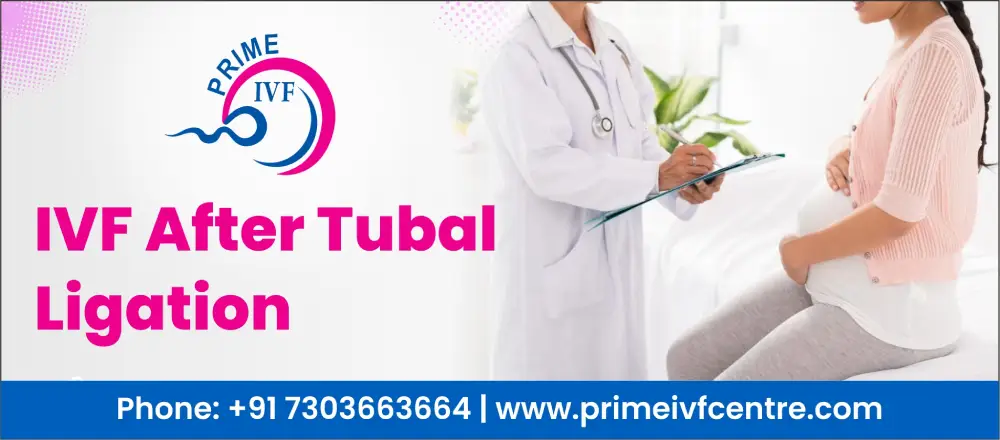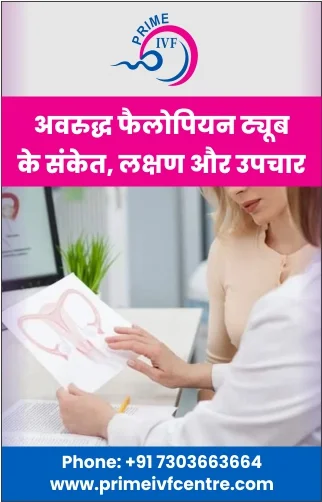IVF After Tubal Ligation

- 13 Nov, 2023
- SEO
- infertility
- Medically Reviewed By:
 Dr. Nishi Singh
Dr. Nishi Singh - Author: Prime IVF Centre
Deciding to have a tubal ligation is a significant choice for many individuals. It offers a sense of finality in terms of contraception, providing a reliable and permanent solution. However, life is full of surprises, and circumstances can change. If you find yourself yearning to expand your family after undergoing tubal ligation, there is hope. In this blog, we will delve into the world of IVF (In Vitro Fertilization) after tubal ligation. We will explore the possibilities, success rates, considerations, and potential challenges associated with this fertility option.
Understanding Tubal Ligation
Tubal ligation, often referred to as "having your tubes tied," is a surgical procedure that involves closing or blocking the fallopian tubes. This prevents eggs from traveling to the uterus, effectively preventing pregnancy. Many individuals choose tubal ligation as a permanent contraceptive method due to personal reasons, such as financial stability, health concerns, or family size considerations. However, the desire to have a child later in life can become a reality through alternative methods like IVF.
IVF: An Overview
In Vitro Fertilization (IVF) is a widely known and successful assisted reproductive technology. It involves the retrieval of eggs from the ovaries, fertilizing them with sperm in a laboratory, and transferring the resulting embryos to the uterus. IVF offers hope to individuals and couples struggling with infertility, including those who have undergone tubal ligation. Unlike natural conception, IVF bypasses the fallopian tubes, making it a potential solution for achieving pregnancy after tubal ligation.
IVF After Tubal Ligation: Considerations and Preparations
Before embarking on the IVF journey after tubal ligation, it is crucial to consult with fertility specialists and seek medical advice. They will evaluate your individual circumstances and provide personalized guidance. Medical examinations and tests will be conducted to assess your reproductive health, hormone levels, and overall well-being. This thorough evaluation allows the fertility team to develop an appropriate treatment plan tailored to your specific needs.
Navigating the emotional aspects of IVF after tubal ligation is equally important. It is normal to experience a range of emotions, including excitement, anxiety, and even sadness. Giving yourself time to process these feelings and seeking support from loved ones or professional IVF specialists can make the journey more manageable.
How Successful is IVF after Tubal Ligation?
Understanding the success rates of IVF after tubal removal is essential for managing expectations, especially for individuals who are 40 years of age or older. IVF success at 40 after tubal ligation is a subject of significance. While success rates may vary, IVF can still offer hope for those seeking to conceive at this age, even after tubal ligation. Factors such as overall health, fertility history, and the specific tubal ligation technique used, plays a role in IVF success rates.
Although success rates may be slightly lower compared to younger individuals, advancements in reproductive technology have improved outcomes for older women undergoing IVF. It is important to have realistic expectations and consult with a fertility specialist who can provide personalized guidance. With proper medical care and a proactive approach, it is still possible to achieve a successful pregnancy and fulfill the dream of expanding one's family, even at the age of 40 or older after tubal ligation.
Potential Challenges and Complications
While IVF after tubal ligation offers hope, it is important to be aware of potential challenges and complications along the way. IVF is a complex process and not every attempt results in pregnancy. Multiple pregnancies, where two or more embryos implant successfully, pose their own set of challenges and risks. Additionally, ovarian hyperstimulation syndrome (OHSS) is a potential complication that requires careful monitoring and management. Being informed about these potential challenges allows you to approach the process with realistic expectations and a prepared mindset.
Managing the emotional and physical challenges that may arise during IVF after tubal removal is crucial. Building a strong support system, engaging in self-care practices, and seeking professional help when needed can make a significant difference in navigating these obstacles.
Alternatives and Options
IVF after tubal removal is not the only option for individuals seeking to conceive after undergoing the procedure. There are other alternatives available that can be explored to fulfill the desire for parenthood. One such alternative is tubal ligation reversal surgery. This surgical procedure aims to reestablish the patency of the fallopian tubes, allowing for natural conception to occur.
The success rates of tubal ligation reversal surgery vary depending on several factors, including the type of tubal ligation performed and the length of time that has elapsed since the initial procedure. It is important to consult with a fertility specialist to assess the feasibility and potential success of this option based on individual circumstances.
Another alternative worth considering is using a gestational carrier. This option involves another woman carrying and giving birth to a child on behalf of the intended parents. Gestational carriers can be an excellent option for individuals who are unable to carry a pregnancy themselves due to various medical reasons or after tubal removal.
However, it is essential to carefully evaluate the legal, ethical, and emotional implications associated with this alternative, as well as the financial considerations involved. Exploring these alternatives and discussing them with your fertility specialist will help you make an informed decision that aligns with your goals and circumstances.
Ultimately, the choice between IVF after tubal removal, tubal ligation reversal surgery, or using a gestational carrier depends on individual circumstances, preferences, and medical recommendations. Working closely with a fertility specialist will provide the necessary guidance and support to make an informed decision that can lead to the fulfillment of the dream of starting or expanding a family.
Conclusion
Embarking on the journey of IVF after tubal ligation is a profound decision that offers renewed hope and possibilities for individuals seeking to expand their families. As you navigate this path, it is crucial to approach it with a sense of realistic optimism and surround yourself with the right support system.
If you find yourself considering IVF after tubal ligation and have further questions or need assistance, Prime IVF Centre is a reliable resource. Our dedicated team of fertility specialists is available to provide you with comprehensive information, personalized guidance, and compassionate support.
Embrace the hope that IVF after tubal ligation can bring and take the first step towards fulfilling your cherished dream of parenthood. Your journey may have had its obstacles, but with determination and the right resources, the joy of holding your own child may be just around the corner.

